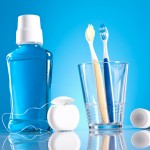
Alcohol has been used in mouthrinses as a solvent for agents such chlorhexidine (CHX), cetylpyridinium chloride (CPC) and essential oils. However for or certain groups of people, for example those with previous alcohol problems, pregnant women, children or members of some religious groups, alcohol-containing mouthrinses are not appropriate.
The aim of this study was to test the efficacy of two alcohol-free antimicrobial mouthwashes in reducing plaque and gingivitis compared to an alcohol-containing rinse and toothbrushing alone.
Methods.
This was a single centre study. Health adult patients with a minimum of 20 permanent teeth were eligible for inclusion. Patients were stratified by sex and papillary bleeding index (PBI) and randomised into 4 groups; (A) toothbrushing + rinsing (0.06% chlorhexidine [CHX] + 0.025% sodium fluoride [NaF], alcohol-containing rinse, positive control); (B) toothbrushing + rinsing (0.06% CHX + 0.025% NaF, alcohol-free experimental rinse); (C) toothbrushing + rinsing (0.06% CHX + 0.03% cetylpyridinium chloride [CPC] + 0.025% NaF, alcohol-free experimental rinse); (D) toothbrushing alone (negative control).
All patients received oral hygiene instruction toothpaste without antibacterial agents and a new toothbrush. No specific brushing technique was described or duration recommended. Patients in the rinsing group were advised to wait for 30 minutes before rinsing for 10 seconds and refrain for drinking, eating and rinsing for at least 30 mins. Interproximal cleaning devices (floss, water pik, toothpicks) had been permitted if they were part of the usual oral hygiene routine of the included subjects.
At baseline Modified Proximal Plaque Index (MPPI), Quigley-Hein Plaque Index (QHI) Papillary Bleeding Index (PBI) and smoking habits were recorded. These were also recorded at 4 and 8 weeks. Primary outcomes were MPPI,QHI and PBI.
Results
- 160 patients were randomised, 40 per group
- 155 were analysed at 8 weeks (Group A=39;B=39; C=37; D= 40)
- The was no statistically significant diference between the 4 groups for PBI
- After 4 and 8 weeks the the two experimental rinses (groups B&C) ) showed no statistically significant difference to the positive control ( Group A)
- There was statistically more staining in the 3 rinsing groups compared with group D.
Mean percentage improvements from baseline to 8 weeks.
| CHX+NaFAlcohol rinse
(Group A) |
CHX+NaFAlcohol free rinse
(Group B) |
CHX+CPCAlcohol free rinse
(Group C) |
Toothbrushing alone
(Group D) |
|
| Modified Proximal Plaque Index | 36.6% | 32.3% | 36.8% | 21.6% |
| Quigley-Hein Plaque Index | 11.9% | 12.2% | 13.6% | 3.5% |
| Papillary Bleeding Index | 80.2% | 77.8% | 76.5% | 73.4% |
Conclusions
It can be concluded from the present study that the removal of alcohol from the CHX-containing mouthrinse does not seem to have a negative effect on its efficacy. Therefore, the product containing 0.06% CHX without alcohol should be recommended instead of the alcohol-containing one.
Note:- This study was funded by GlaxoSmithKline Consumer Healthcare (Bűhl,Germany).
Commentary
This study has been designed as an equivalence study and suggests that outcomes are similar between all the mouthrinses. It is interesting to note that the results for interproximal bleeding (PBI) are not significantly different between the 4 groups and also that plaque has reduced in all 4 groups although it is greater in the 3 mouthrinse groups. While the plaque reduction between the 4 groups is statistically different the question as to whether this is clinically important needs to be taken into consideration. It also needs to be borne in mind that this is just a short-term study and all 3 mouthrinses groups experienced more staining that the toothbrushing alone group.
Links
Zimmer S, Korte P, Verde P, Ohmann C, Naumova E, Jordan R. Randomized controlled trial on the efficacy of new alcohol-free chlorhexidine mouthrinses after 8 weeks. Int J Dent Hyg. 2014 Nov 9. doi: 10.1111/idh.12111. [Epub ahead of print] PubMed PMID: 25382448.

Don’t miss – Mouthrinses: alcohol-free rinses have similar effects on plaque levels to those with alcohol http://t.co/bIdYYWxkS3